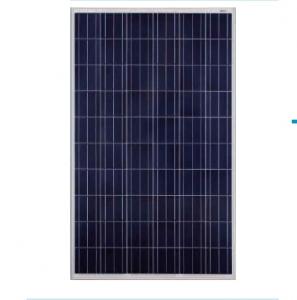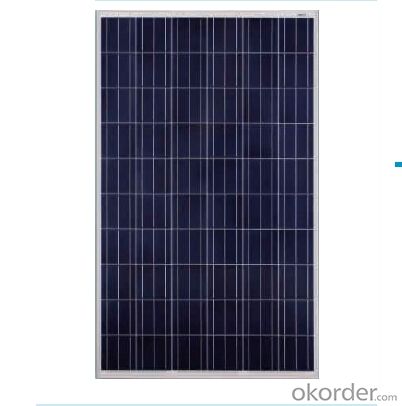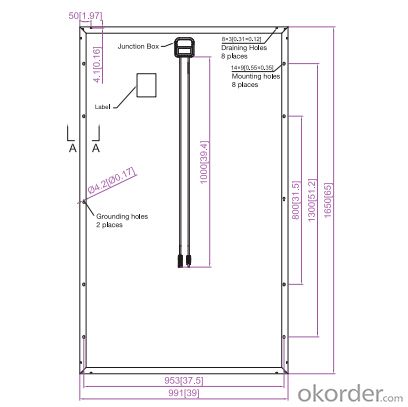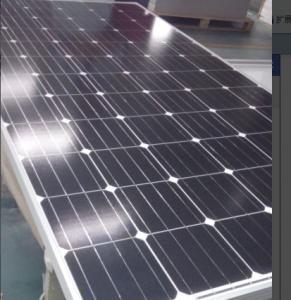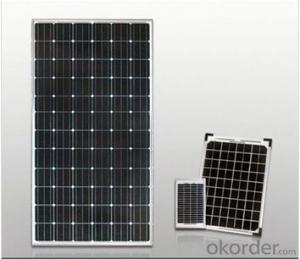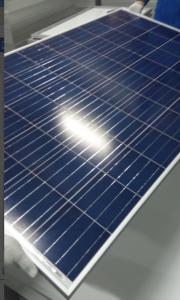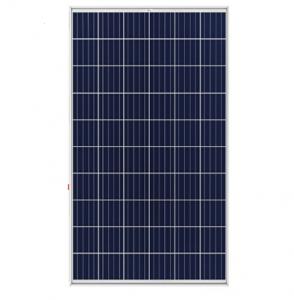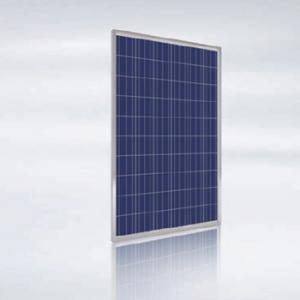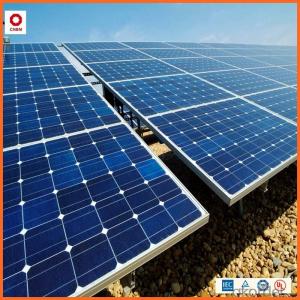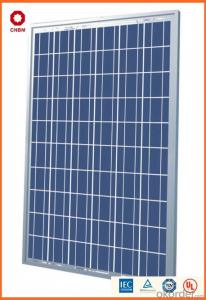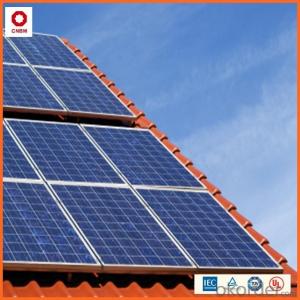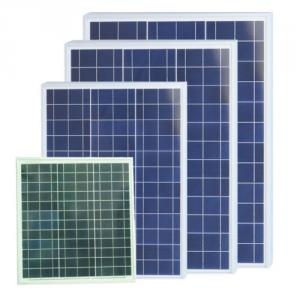Pud Solar Panels ☆☆☆ Poly Solar Panels Stock $0.39/w ☆☆☆ Tire 1 Brand Quality Standard Quite Cheap Price
- Loading Port:
- China Main Port
- Payment Terms:
- TT or LC
- Min Order Qty:
- 1000000 watt
- Supply Capability:
- 1000000 watt/month
OKorder Service Pledge
Quality Product, Order Online Tracking, Timely Delivery
OKorder Financial Service
Credit Rating, Credit Services, Credit Purchasing
You Might Also Like
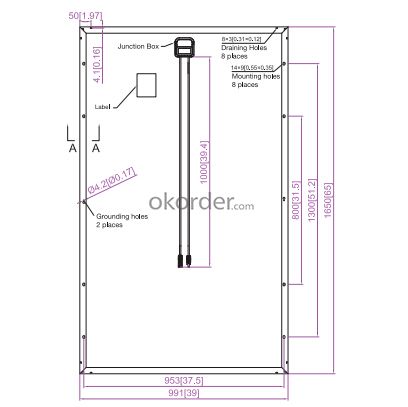
- Q: Can solar panels be installed in areas with high humidity?
- Yes, solar panels can be installed in areas with high humidity. While humidity can affect the performance of solar panels to some extent, it does not prevent their installation or significantly diminish their overall effectiveness.
- Q: I know that one LED can't power a solar panel. I have found 40 kmcd LED's on OKorder. I know that several of them (28 totale each one with a 470 ohm resistor all at 2 VDC) can show a reflection on a wall in daylight 60 feet away..
- The 40 kmcd rating is a measure of luminous intensity (how bright it looks), not a measure of output power of the visible light. We can estimate the performance of your proposed system as follows: The LEDs on OKorder each are rated about 20mA maximum at about 3.2V, or 64mW (milliwatts). If you use 470 ohm resistors connected to 2VDC, the current that will flow, per LED, will be about: (2V-3.2V)/470ohm = 0.0872A = 8.72mA The power taken from the 2VDC power source will be: P2v = 2V x 8.72mA = 224.6mW (per LED) The power input to each LED will be about: Pled = 3.2V x 8.72mA = 59.9mW (per LED) The LED has a luminous efficiency that can range from about 4.2% to 22%. This efficiency is the ratio of the amount of visible light output (in watts) divided by the input power (in watts). The OKorder listing doesn't identify the output power level (either in watts or in lumens), so let's assume a 0% efficiency. The LED output power will be about: Pout = 59.9mW x 0% = 5.99mW (per LED) A solar panel converts visible light to electrical energy with an efficiency that ranges say about 6% to 8%. Suppose the solar panel efficiency is 2%. Then the electrical power output by the panel will be about : Pe = 5.99mW x 2% = 0.72mW (per LED) If you shine 00 LEDs on the panel, the output electrical power will be 00 times that amount: Pe00 = 0.72mW/LED x 00 LED = 72mW <===ANSWER The power taken from your 2V source will be about: P2V00 = 224.6mW/LED x 00 LED = 22460mW = 22.46W The system efficiency will be about: Eff = solar output / battery input = Pe00 / P2V00 = 72mW / 22460mW x 00% = 0.32% SUMMARY: If you shine 00 of the LEDs on the panel, you will capture back about 0.32% of the energy expended, or regain about 72mW.
- Q: Can solar panels be used in remote areas?
- Yes, solar panels can be used in remote areas. They are a popular and viable solution for generating electricity in locations that are not connected to the traditional power grid. Solar panels can be set up in remote areas to harness energy from the sun and provide electricity for various purposes, such as lighting, powering small appliances, or even charging batteries. Their ability to operate independently without the need for extensive infrastructure makes them an ideal choice for remote areas where access to electricity is limited or non-existent.
- Q: Can solar panels be installed on hospitals or healthcare facilities?
- Yes, solar panels can be installed on hospitals or healthcare facilities. In fact, many healthcare facilities are increasingly adopting solar energy as a sustainable and cost-effective solution. Solar panels can help hospitals reduce their dependence on traditional energy sources, lower operating costs, and contribute to a greener environment.
- Q: So how does a solar panel work? Where does the energy get stored in? How much does one cost for a small 2 family home? How much money would we save on electricity?
- In the short, a solar panel is composed of many solar cells...all tied together and in some sort of a frame for mounting. When energy from the sun hits it, it creates a reaction which can feed electricity through leads to a converter system which takes the Direct Current power and converts it into Alternating Current. If you rewire your house for DC products I suppoes you wo'nt need the converter. but most of these systems are retro-fits. Batteries provide back up source to the system when the sun goes down. So solar is converted to electricity through the panel, which goes to your solar system which both provides power to the house and to recharge batteries. The batteries take over when the sun is down. So you will need to know how much battery capacity you need by calculating the Amp hour rating of your applicances that you normally use at night like Microwave, TV, radio, refrigerator, etc. For some depending on the appliance....water heater (if electric) or stove) then you need to figure out how many panels you need to provide your normal daily energy use, figure out how many batteries you need, set up a distribution system that gives you what you need where you want it and wa la. Once done, you will be off the grid and paying nothing from the electrical utility. Some places due to deregulations allow you to sell excess power to local utilities too, but those systems need to meet tight standards.
- Q: Can solar panels be installed on a library or educational institution?
- Yes, solar panels can be installed on a library or educational institution. In fact, many libraries and educational institutions are increasingly adopting solar energy systems to reduce their carbon footprint, lower energy costs, and promote renewable energy education. Installing solar panels on rooftops or open spaces of these buildings can provide clean and sustainable electricity, benefiting both the institution and the environment.
- Q: Can solar panels be used in areas with high levels of snow or ice?
- Yes, solar panels can be used in areas with high levels of snow or ice. However, the efficiency of solar panels may be reduced during these conditions. Regular maintenance and snow removal are necessary to ensure optimal performance. Additionally, tilted solar panel installation and using anti-reflective coatings can help minimize snow accumulation.
- Q: I need to prepare solar panels for using in home needs electricity purpose. Can anyone could help me to know much more about it.
- Unfortunately, okorder / You could make your own solar water heater, and poasibly save money that way. You could pay a professional to install solar panels for you, and it might actually save money in the long run, depending on where you live. But the up-front investment is usually on the order of $0,000.
- Q: How much energy can a solar panel produce in a day?
- The amount of energy a solar panel can produce in a day depends on various factors such as the size and efficiency of the panel, location, weather conditions, and sunlight exposure. On average, a typical residential solar panel can generate around 4 to 6 kilowatt-hours (kWh) of electricity per day. However, this value can vary significantly and may be higher or lower based on the aforementioned factors.
- Q: How much energy can a solar panel generate?
- The amount of energy a solar panel can generate depends on several factors, including its size, efficiency, and the amount of sunlight it receives. On average, a typical solar panel can generate between 250 to 400 watts of power per hour. However, larger and more efficient solar panels can produce even higher amounts of energy.
Send your message to us
Pud Solar Panels ☆☆☆ Poly Solar Panels Stock $0.39/w ☆☆☆ Tire 1 Brand Quality Standard Quite Cheap Price
- Loading Port:
- China Main Port
- Payment Terms:
- TT or LC
- Min Order Qty:
- 1000000 watt
- Supply Capability:
- 1000000 watt/month
OKorder Service Pledge
Quality Product, Order Online Tracking, Timely Delivery
OKorder Financial Service
Credit Rating, Credit Services, Credit Purchasing
Similar products
Hot products
Hot Searches
Related keywords
